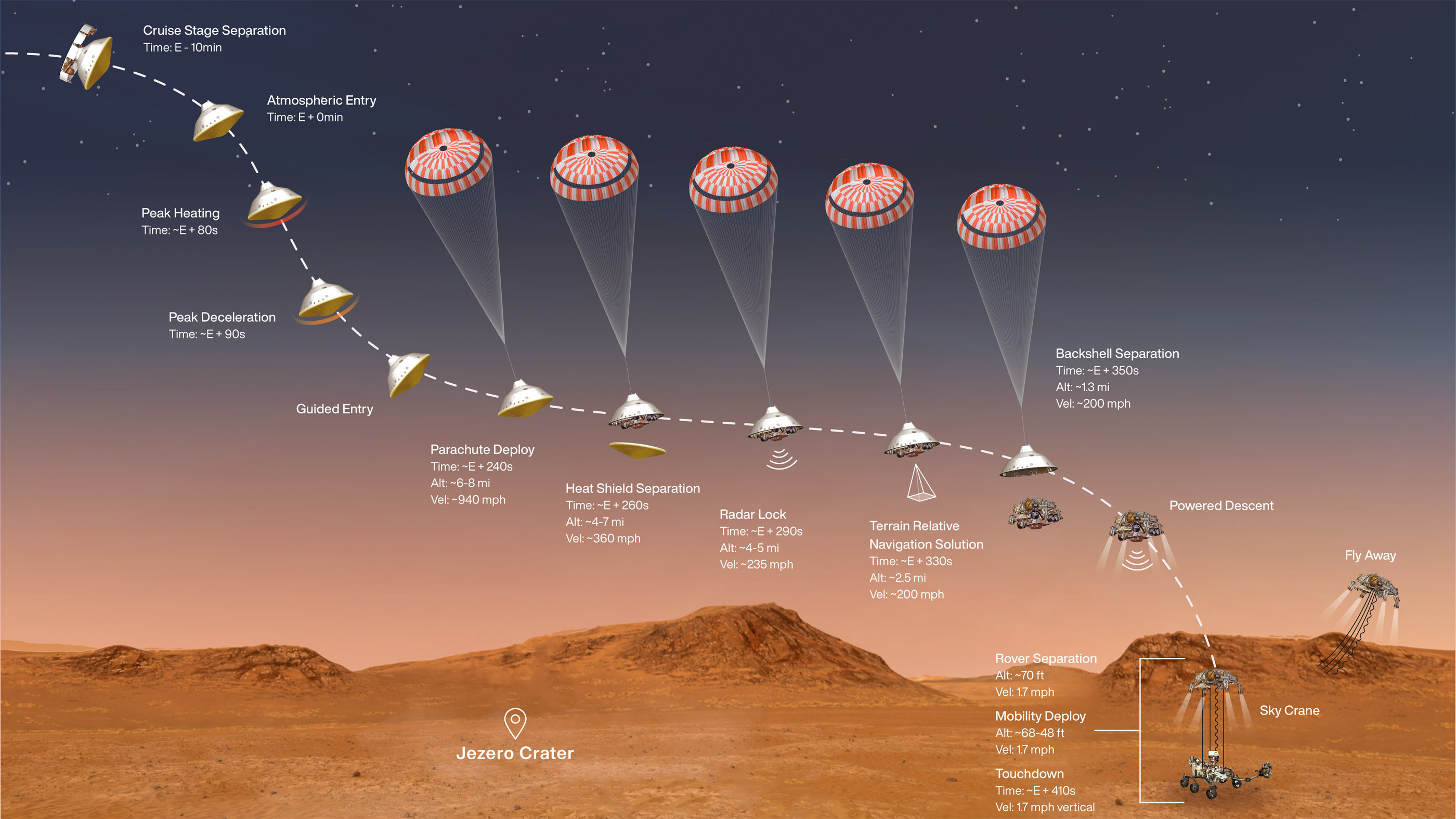Watch NASA's Perseverance rover land on Mars
On Feb. 18, NASA's newest Mars rover, Perseverance, will descend into the Red Planet's atmosphere, braving temperatures equivalent to those on the surface of the sun as it deploys a supersonic parachute in hopes of a safe landing.
Earthbound viewers can follow the nail-biting action at home here on Live Science, on NASA Television or on the NASA website, which will carry live coverage from the Jet Propulsion Laboratory in California. The broadcast begins Feb. 18 at 2:15 p.m. EST (11:15 a.m. local time). There are also news conferences and informational sessions before landing day; a schedule is available on the Perseverance mission website.
The rover will search Mars' Jezero crater for signs of microbial life. The 28-mile-wide (45 kilometers) crater was once a river delta and lake, a moist environment that could have been conducive to life in Mars' past. If all goes as planned, Perseverance will be the first Mars rover to collect samples to return to Earth. Future missions by NASA and the European Space Agency will ferry the Mars rocks back.
Related: Photo tour of Jezero Crater: Here's where Perseverance will land on Mars
A long journey
The rover left for Mars on a United Launch Alliance Atlas V 541 rocket on July 30, 2020, with a 293-million-mile (471 million km) journey ahead of it. Traveling at 1.6 miles per second (2.5 km per second) through space, the rover will have to decelerate quickly when it hits the Martian atmosphere. About 10 minutes before reaching the atmosphere, the rover will drop its fuel tanks and solar panels and sensors used during its trip, a bundle known as the cruise stage. Next, special thrusters will slow the spacecraft's spinning and line it up for planetary entry. With only 5 minutes in space left, the rover will drop two 154-lb. (70 kilograms) weights to lighten its load.
Then come the crucial final 7 minutes. As the rover hits the atmosphere, friction will cause the craft to heat dramatically. It will also slow down quickly, using thrusters to guide it through any turbulence it may meet. With only about 3 minutes to go, the rover will enter a phase NASA is calling "Straighten Up and Fly Right." The spacecraft will drop several more balances and maneuver into an appropriate angle for landing.
At this point, the rover will be 7 miles (11 km) above the Martian surface, traveling at 940 mph (1,512 km/h). Its parachute, 70.5 feet (21.5 meters) in diameter, will explode out of its shell, slowing the craft to 200 mph (320 km/h).
Sign up for the Live Science daily newsletter now
Get the world’s most fascinating discoveries delivered straight to your inbox.
Twenty seconds later, the rover will be on the job. Its heat shields will fall away, exposing cameras and other sensors. They will immediately begin taking in data, even though the rover will still be still 6 miles (9.6 km) from the surface. An automatic navigation system will turn on, allowing the rover to steer for safe landing spots on the terrain below. At a bit over a mile (2 km) from the ground, the rover will detach from its parachute and free-fly to its landing. If all goes well, Perseverance should throttle down to a speed of 1.7 mph (2.7 km/h) just before it lands. NASA's interactive Entry Descent Landing simulator has more detail on these stages.

A rover's mission
Perseverance's mission on Mars will last at least one Martian year, or 687 Earth days. Mars rovers can far outlive their planned missions, however. NASA's Curiosity rover, launched in 2011, was originally intended for a two-year mission but is still roaming the Red Planet more than eight Earth years after landing, and the Spirit rover was active for six years despite a planned mission duration of only 92 Earth days.
Perseverance is equipped with advanced cameras and tools capable of analyzing a rock's composition based on the kind of X-rays it gives off after being zapped with a stream of high-energy X-rays. It has ground-penetrating radar for imaging the subsurface of the planet and a drill for collecting samples from below the surface. The rover will also test whether humans could survive on Mars by transforming the planet's carbon dioxide into oxygen with an experiment called the Mars Oxygen In-Situ Resource Utilization Experiment.
Ultimately, the goal is to look for ancient life or biosignatures left in Mars rocks. The car-sized rover is part of the Mars 2020 mission, which has a goal of eventually sending human explorers to the Red Planet.
Originally published on Live Science.

Stephanie Pappas is a contributing writer for Live Science, covering topics ranging from geoscience to archaeology to the human brain and behavior. She was previously a senior writer for Live Science but is now a freelancer based in Denver, Colorado, and regularly contributes to Scientific American and The Monitor, the monthly magazine of the American Psychological Association. Stephanie received a bachelor's degree in psychology from the University of South Carolina and a graduate certificate in science communication from the University of California, Santa Cruz.









